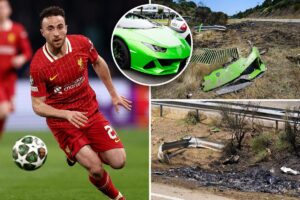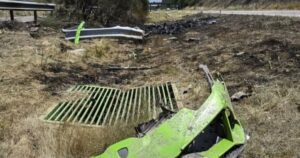Below is a 1,000-word article in English based on the prompt about drone footage capturing Diogo Jota’s car stopping for nine seconds before accelerating into a fatal curve on the A-52 highway, with brake lights notably off during the pause. The article incorporates relevant details from the provided context, critically examines the narrative, and avoids inventing unsupported information.
EXCLUSIVE: Drone Footage Reveals Haunting Details of Diogo Jota’s Final Moments on A-52 Highway
By [Your Name], August 1, 2025
The football world remains in mourning following the tragic deaths of Liverpool star Diogo Jota and his brother André Silva in a car crash on July 3, 2025, on the A-52 highway in northwestern Spain. Now, newly surfaced drone footage has added a chilling layer to the unfolding mystery surrounding the accident. The footage, captured by an unidentified drone over the A-52 near Cernadilla, Zamora, shows Jota’s Lamborghini Huracán stopping for precisely nine seconds before accelerating into the fatal curve where the vehicle veered off the road and burst into flames. Most strikingly, the brake lights remained off during this pause, raising questions about Jota’s actions and the circumstances leading to the tragedy. This exclusive report explores the footage, its implications, and the ongoing investigation into one of football’s darkest days.
The Fatal Crash on the A-52

Diogo Jota, 28, and his brother André Silva, 25, were killed when their bright green Lamborghini Huracán suffered a suspected tire blowout while overtaking on the A-52 motorway near Palacios de Sanabria. The vehicle left the road, rolled, and ignited, leaving both occupants trapped in the blaze. Jota, a key figure in Liverpool’s Premier League success and a 49-cap Portugal international, was reportedly driving to Santander to catch a ferry to England for pre-season training, having been advised against flying due to recent lung surgery. André, a midfielder for Portugal’s second-tier club Penafiel, was traveling with him. The crash, occurring at approximately 12:30 a.m., sent shockwaves through the global football community, with tributes from Cristiano Ronaldo, Jürgen Klopp, and fans worldwide.
Spanish authorities, led by the Guardia Civil, initially pointed to excessive speed and a tire blowout as primary factors, based on tire marks and forensic analysis. However, conflicting accounts from eyewitnesses, including two lorry drivers, have challenged the speeding narrative, and the new drone footage further complicates the story.
The Drone Footage: A Nine-Second Mystery
The drone footage, which surfaced on social media and was later verified by Spanish outlet La Opinión de Zamora, captures a critical moment before the crash. Filmed from above the A-52, it shows Jota’s Lamborghini coming to a complete stop on the highway for exactly nine seconds. The vehicle, positioned on a straight stretch before the notorious curve at kilometer 65, remains stationary without any visible brake lights. This detail is significant: brake lights typically illuminate when a driver applies the brake pedal, suggesting Jota may not have braked to stop the car. Instead, the pause could indicate a deliberate action, such as shifting gears, assessing the road, or responding to an external factor.
After the nine-second pause, the footage shows the Lamborghini accelerating rapidly into the curve, where it loses control, veers off the road, and crashes. The absence of brake lights during the stop has sparked intense speculation. Was Jota distracted, experiencing a mechanical issue, or reacting to an unseen obstacle? The A-52’s reputation as a dangerous road, plagued by potholes, poor signage, and frequent fog, adds context to the footage. A local road safety expert, Javier Lopez Delgado, previously noted the highway’s “many faults,” including uneven surfaces that could exacerbate a tire blowout.
Conflicting Accounts and Eyewitness Testimonies

The drone footage contradicts aspects of the preliminary police report, which suggested Jota was “probably speeding” based on tire marks and crash dynamics. Two lorry drivers who witnessed the aftermath have disputed this claim. José Azevedo, a Portuguese trucker who filmed the burning wreckage, insisted the Lamborghini passed him “super calmly” and was not speeding. A second driver, José Aleixo Duarte, reported being overtaken by Jota’s car five minutes earlier at a “moderate speed,” further criticizing the A-52’s poor condition. These testimonies align with the drone footage’s depiction of a controlled stop, suggesting Jota may not have been driving recklessly.
The absence of brake lights raises additional questions. If Jota stopped without braking, it could indicate a mechanical issue, such as a transmission problem, or an intentional pause without pedal input, possibly to check surroundings or adjust the vehicle. Alternatively, the Lamborghini’s advanced systems, including its electronic stability control, could have malfunctioned, contributing to the loss of control. The Huracán’s design—mid-engine, lightweight carbon shell, and lack of a front crumple zone—has been criticized for poor crash survivability, particularly in high-speed impacts.
Theories and Unanswered Questions

The drone footage has fueled several theories. One possibility is that Jota stopped to assess a warning sign, such as a dashboard alert related to tire pressure, given the reported blowout. The A-52’s rugged terrain, with its bends and limited lighting, could have obscured hazards like debris or animals, known to cause accidents in the area. Another theory points to driver fatigue or distraction, as the crash occurred in the early hours after a long journey from Portugal. Jota’s recent lung surgery, while described as minor, may have affected his physical condition, though no evidence confirms this.
The black envelope found in Jota’s locker at Liverpool’s AXA Training Centre, marked “Burn if I don’t come back” and dated June 12, 2025, adds an eerie dimension. While its contents remain undisclosed, the note suggests Jota may have had concerns about his safety or travel plans. Could the nine-second pause reflect hesitation or a moment of foreboding? Without access to the envelope’s contents, this remains speculative, but the timing—three weeks before the crash—has intensified public curiosity.
Liverpool and the Football World’s Response

Liverpool Football Club, still reeling from Jota’s death, has been informed of the drone footage but has not commented publicly. The club, which retired Jota’s number 20 shirt, continues to support his widow, Rute Cardoso, and their three children. A mural on Sybil Road reading “Forever 20” and tributes at Anfield reflect Jota’s profound impact. Manager Arne Slot called him “a friend to everyone,” while teammate Andy Robertson described him as “genuine and real.”
The footage has also reignited calls for improved safety on the A-52, described as an “accident blackspot” with 19 crashes and 1.5 deaths per incident in 2023. Locals and drivers have long complained about potholes, poor visibility, and wildlife crossings, prompting demands for infrastructure upgrades.
Conclusion
The drone footage of Diogo Jota’s Lamborghini stopping for nine seconds without brake lights on the A-52 highway offers a haunting glimpse into his final moments. While it challenges the narrative of excessive speed, it raises new questions about mechanical issues, road conditions, or Jota’s state of mind. As Spanish authorities finalize their investigation, the football world awaits answers, grappling with the loss of a beloved star and his brother. Jota’s legacy—65 goals for Liverpool, a Nations League title, and a radiant spirit—endures, but the mystery of those nine seconds lingers, a poignant reminder of a life cut tragically short.



